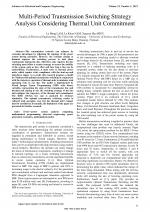| 1/2023 - 6 |
Multi-Period Transmission Switching Strategy Analysis Considering Thermal Unit CommitmentLAM, L. H. |
| Extra paper information in |
| Click to see author's profile in |
| Download PDF |
Author keywords
power system analysis computing, mathematical programming, electrical engineering, power generation economics, mathematical model
References keywords
power(28), switching(20), transmission(16), tpwrs(15), optimal(11), neill(7), oren(6), hedman(6), fisher(6), systems(5)
Blue keywords are present in both the references section and the paper title.
About this article
Date of Publication: 2023-02-28
Volume 23, Issue 1, Year 2023, On page(s): 51 - 60
ISSN: 1582-7445, e-ISSN: 1844-7600
Digital Object Identifier: 10.4316/AECE.2023.01006
Web of Science Accession Number: 000937345700006
SCOPUS ID: 85150204229
Abstract
The transmission network can enhance its economic advantages by adjusting the topology of the power system during operation. However, the constant change in demand requires the switching process to take place continuously during the day. Therefore, this requires the line switching must follow a certain strategy to ensure the stability of the system, such as how often and how long a line can be online/offline. Furthermore, it must refer to thermal power units, which require strict compliance with the start-up and shut-down stages. As a result, this research proposes a model for Multi-period optimal transmission switching in conjunction with the trajectory operation of thermal units to minimize total operating costs in one day. The model is implemented by Mixed Integer Linear Programming (MIP) with binary variables representing the state of the transmission line and thermal unit aiming to sets the switching strategy of the line and configure the trajectory of the thermal unit commitment. The IEEE 118-bus test case is analyzed for 24-hours simulation. The optimal transmission switching results in reduced total operation cost, but the thermal unit's impact must be considered. Eventually, the limitations of the paper are presented for further research. |
| References | | | Cited By |
Web of Science® Times Cited: 1 [View]
View record in Web of Science® [View]
View Related Records® [View]
Updated 4 days, 7 hours ago
SCOPUS® Times Cited: 1
View record in SCOPUS® [Free preview]
View citations in SCOPUS® [Free preview]
[1] Optimal Transmission Switching for Congestion Management and Cost Reduction Using Linearized AC Optimal Power Flow, Habibi, Mohammad, Zangeneh, Ali, A., Johny Renoald, International Transactions on Electrical Energy Systems, ISSN 2050-7038, Issue 1, Volume 2025, 2025.
Digital Object Identifier: 10.1155/etep/3620842 [CrossRef]
Disclaimer: All information displayed above was retrieved by using remote connections to respective databases. For the best user experience, we update all data by using background processes, and use caches in order to reduce the load on the servers we retrieve the information from. As we have no control on the availability of the database servers and sometimes the Internet connectivity may be affected, we do not guarantee the information is correct or complete. For the most accurate data, please always consult the database sites directly. Some external links require authentication or an institutional subscription.
Web of Science® is a registered trademark of Clarivate Analytics, Scopus® is a registered trademark of Elsevier B.V., other product names, company names, brand names, trademarks and logos are the property of their respective owners.
Faculty of Electrical Engineering and Computer Science
Stefan cel Mare University of Suceava, Romania
All rights reserved: Advances in Electrical and Computer Engineering is a registered trademark of the Stefan cel Mare University of Suceava. No part of this publication may be reproduced, stored in a retrieval system, photocopied, recorded or archived, without the written permission from the Editor. When authors submit their papers for publication, they agree that the copyright for their article be transferred to the Faculty of Electrical Engineering and Computer Science, Stefan cel Mare University of Suceava, Romania, if and only if the articles are accepted for publication. The copyright covers the exclusive rights to reproduce and distribute the article, including reprints and translations.
Permission for other use: The copyright owner's consent does not extend to copying for general distribution, for promotion, for creating new works, or for resale. Specific written permission must be obtained from the Editor for such copying. Direct linking to files hosted on this website is strictly prohibited.
Disclaimer: Whilst every effort is made by the publishers and editorial board to see that no inaccurate or misleading data, opinions or statements appear in this journal, they wish to make it clear that all information and opinions formulated in the articles, as well as linguistic accuracy, are the sole responsibility of the author.



